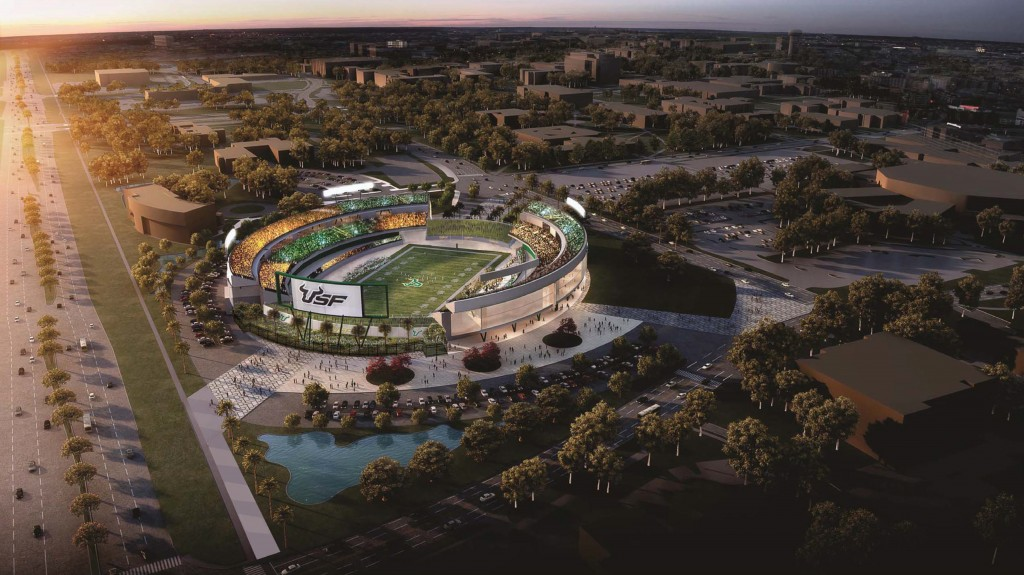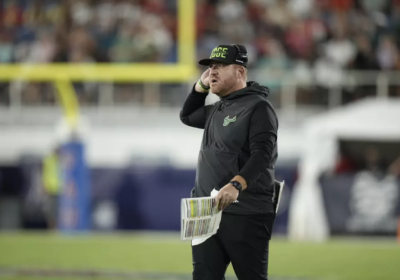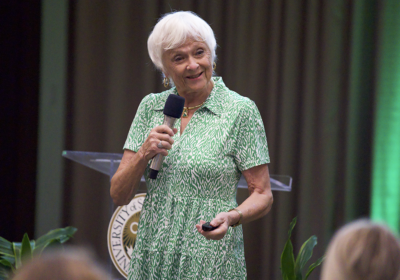BOT approves $340 million budget for on-campus stadium, Faculty Senate president expresses disapproval

A $340 million budget for an on-campus stadium is one step closer to reality after approval from the full Board of Trustees (BOT) at their meeting on Tuesday morning. The measure passed by a 4-1 vote, but not without some concerns from faculty.
While the decision marks a historic moment in USF Athletics’ history, the proposal still needs to pass one final hurdle. The project will seek approval from the University’s Board of Governors in a two-day meeting on Aug. 29-30.
It is estimated to be completed in July 2026.
As a part of the budget plan, USF will take on a $200 million loan with a 20‐year term starting in the 2024 fiscal year.
Additionally, the remaining $140 million will come from the school. Its portion of the financing will be through $50 million in donations from the USF Foundation, $34 million from auxiliary funds and proceeds from the 2017 FCC auction of TV broadband, $31 million from the capital improvement trust fund and $25 million in cash.
The stadium will feature 35,000 seats, with multiple premium areas and experiences to support the football and women’s lacrosse programs. It includes five levels – field level, the main concourse, club level, suite level and press level.
Trustee Jenifer Jasinski Schneider was the only member who voted against the project.
As Faculty Senate president, she voiced three main concerns that the faculty holds with the project– the benefits of the stadium to the Tampa campus, financing and budgeting concerns and what that means for the entire university and the servicing of the $200 million debt.
Expenses such as the $18 million it would cost to move intramural fields from the OCS’ proposed build site, Sycamore Fields, to other parts of campus and $26 million in infrastructure to the east part of campus were not included in the estimated price tag, according to Schneider.
“That’s $44 million more making it a $385 million project. And I know it’s not the end because we all know that when building things, other events are going to happen around us,” Schneider said.
Schneider brought up the possibility of installing a firewall between the athletic debt and academics in case the Bulls can’t service the $17.8 million in annual debt through funding such as ticket sales, which greatly depends on team performance.
In a CSL study done in 2017, it estimated that a new on-campus stadium could generate $20.5 million in revenue and incur $5.3 million in expenses, resulting in a net income of up to approximately $15.2 million in the first year of operations.
After accounting for approximately $1.8 million in existing net income at Raymond James Stadium, it is estimated that adjusted net income could shrink to approximately $13.4 million, more than $4 million short of the annual debt USF is taking on.
“It’s a huge endeavor. We build buildings without something like this. And so the funds being diverted from other academic sources are very concerning to us,” Schneider said.
Chair Will Weatherford responded by alluding to schools within their own conference — such as UCF, Cincinnati and Houston who will join the Big 12 this season — that made similar investments in their athletic programs that have gone on to bigger conferences and could benefit from larger TV deals there.
Weatherford’s response also echoed similar sentiments he had when he said that “it was time” for an on-campus stadium during a groundbreaking ceremony for the indoor practice facility in September 2021.
“It is a risk to build a football stadium, but I believe that it is a greater risk not to do it. We risk falling behind,” Weatherford said during the BOT meeting.
Protections are in place according to the Bulls’ contract with their design-build team Populous and Barton Marlow. USF can leave the contract before a guaranteed maximum price range is presented next spring or summer.
USF will also receive $2 million in damages from the construction company for every home game that the stadium is unavailable for use during the 2026 season.
The Bulls have only ever played home games at Raymond James Stadium, then called Tampa Stadium, since their inaugural season back in 1997.
In a span of 10 years, they were arguably one of the fastest-growing football programs in the country. In 2007, USF was the No. 2 ranked team in the country, held a 9-4 record and attendance averaged just around 50,000 under then-head coach Jim Leavitt.
However, not having the infrastructure in place to build on-campus facilities handicapped the program’s ability to sustain that success through recruiting top-tier players. USF is currently rebuilding from a 1-11 season and has won just four games in the last three seasons. During that span, USF failed to garner a top-75 recruiting class, according to the 247 Composite.
The Bulls are preparing to start their first under rookie head coach Alex Golesh. Time will tell if the program can reach the success it saw during the mid-late 2000s, but the stadium represents further proof of the university’s focus on athletics.






